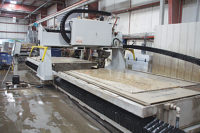Personally, I don’t know that I would be going for an edge detail like that — the fabricator agreed that this is not likely the start of an explosive “scalloped edge trend” — but from a perspective of pure stoneworking, it is certainly interesting.
Considering the “peaks and valleys” that go along with an edge detail like that, an incredible amount of precision was required to fabricate that job. Blackmon didn’t need any special equipment and tooling — just his waterjet with its regular software and a CNC router. It was slow to process, but flawless in its execution.
In discussing the project, Blackmon pointed out that this type of work could not be done by hand; there is just too much precision required. “All of those peaks and valleys have to be perfectly spaced,” he said. “With a scalloped edge, once you get to the corner, you could be going into a ‘valley,’ so it took a little bit of work to make it look good. A straight line was no problem, but the transition to inside and outside corners took some work.”
Blackmon also astutely pointed out that he didn’t want the job going to a shop without the right technology in place, and I concur with this thought. Projects that don’t go as planned don’t reflect well on our trade, and I am in full agreement that it would be extremely difficult — and probably impossible — to complete this job by hand.
At a time when our industry is trying to find ways to increase margins and differentiate themselves from the competition, including competing stone processors and alternative materials, projects like the one in South Carolina stand as an example of the kind of craftsmanship that our stoneworking professionals can achieve. Again, whether you like the actual design or not is irrelevant — particularly when the customer is willing to pay you to execute his vision.
The fact of the matter is that there are customers out there willing to pay a premium for stonework that is different from the run-of-the-mill jobs. As the economy continues to improve, it is my guess that we will be seeing more and more of this specialty work in the future, and the shops that offer this type of processing will be the ones that can get the margins they are looking for.



